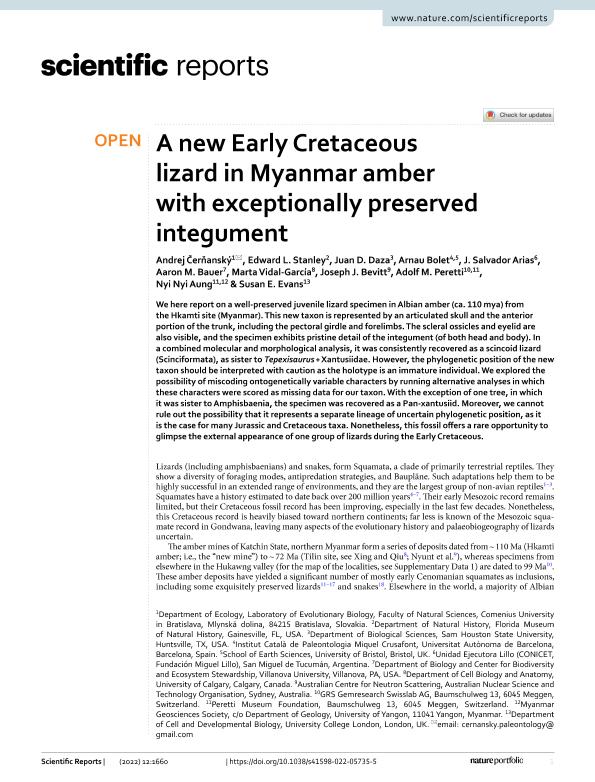Artículo
A new Early Cretaceous lizard in Myanmar amber with exceptionally preserved integument
Cerñanský, Andrej; Stanley, Edward L.; Daza, Juan D.; Bolet, Arnau; Arias Becerra, Joan Salvador ; Bauer, Aaron M.; Vidal García, Marta; Bevitt, Joseph J.; Peretti, Adolf M.; Aung, Nyi Nyi; Evans, Susan E.
; Bauer, Aaron M.; Vidal García, Marta; Bevitt, Joseph J.; Peretti, Adolf M.; Aung, Nyi Nyi; Evans, Susan E.
 ; Bauer, Aaron M.; Vidal García, Marta; Bevitt, Joseph J.; Peretti, Adolf M.; Aung, Nyi Nyi; Evans, Susan E.
; Bauer, Aaron M.; Vidal García, Marta; Bevitt, Joseph J.; Peretti, Adolf M.; Aung, Nyi Nyi; Evans, Susan E.
Fecha de publicación:
12/2022
Editorial:
Nature Research
Revista:
Scientific Reports
ISSN:
2045-2322
Idioma:
Inglés
Tipo de recurso:
Artículo publicado
Clasificación temática:
Resumen
We here report on a well-preserved juvenile lizard specimen in Albian amber (ca. 110 mya) from the Hkamti site (Myanmar). This new taxon is represented by an articulated skull and the anterior portion of the trunk, including the pectoral girdle and forelimbs. The scleral ossicles and eyelid are also visible, and the specimen exhibits pristine detail of the integument (of both head and body). In a combined molecular and morphological analysis, it was consistently recovered as a scincoid lizard (Scinciformata), as sister to Tepexisaurus + Xantusiidae. However, the phylogenetic position of the new taxon should be interpreted with caution as the holotype is an immature individual. We explored the possibility of miscoding ontogenetically variable characters by running alternative analyses in which these characters were scored as missing data for our taxon. With the exception of one tree, in which it was sister to Amphisbaenia, the specimen was recovered as a Pan-xantusiid. Moreover, we cannot rule out the possibility that it represents a separate lineage of uncertain phylogenetic position, as it is the case for many Jurassic and Cretaceous taxa. Nonetheless, this fossil offers a rare opportunity to glimpse the external appearance of one group of lizards during the Early Cretaceous.
Palabras clave:
Myanmar
,
Gondwana
,
Cretácico
,
Squamata
Archivos asociados
Licencia
Identificadores
Colecciones
Articulos(UEL)
Articulos de UNIDAD EJECUTORA LILLO
Articulos de UNIDAD EJECUTORA LILLO
Citación
Cerñanský, Andrej; Stanley, Edward L.; Daza, Juan D.; Bolet, Arnau; Arias Becerra, Joan Salvador; et al.; A new Early Cretaceous lizard in Myanmar amber with exceptionally preserved integument; Nature Research; Scientific Reports; 12; 1; 12-2022; 1-12
Compartir
Altmétricas



